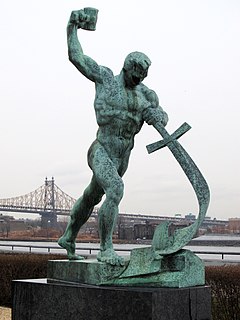
Nuclear disarmament is the act of reducing or eliminating nuclear weapons. It can also be the end state of a nuclear-weapons-free world, in which nuclear weapons are completely eliminated. The term denuclearization is also used to describe the process leading to complete nuclear disarmament.

Disarmament is the act of reducing, limiting, or abolishing weapons. Disarmament generally refers to a country's military or specific type of weaponry. Disarmament is often taken to mean total elimination of weapons of mass destruction, such as nuclear arms. General and Complete Disarmament was defined by the United Nations General Assembly as the elimination of all WMD, coupled with the “balanced reduction of armed forces and conventional armaments, based on the principle of undiminished security of the parties with a view to promoting or enhancing stability at a lower military level, taking into account the need of all States to protect their security.”

A number of peace symbols have been used many ways in various cultures and contexts. The dove and olive branch was used symbolically by early Christians and then eventually became a secular peace symbol, popularized by a Dove lithograph by Pablo Picasso after World War II. In the 1950s the "peace sign", as it is known today, was designed by Gerald Holtom as the logo for the British Campaign for Nuclear Disarmament (CND), a group at the forefront of the peace movement in the UK, and adopted by anti-war and counterculture activists in the US and elsewhere. The symbol is a super-imposition of the semaphore signals for the letters "N" and "D", taken to stand for "nuclear disarmament", while simultaneously acting as a reference to Goya's The Third of May 1808 (1814).

Bruce Kent was a British Roman Catholic priest who became a political activist in the Campaign for Nuclear Disarmament, and held various leadership positions in the organisation.

The Committee of 100 was a British anti-war group. It was set up in 1960 with a hundred public signatories by Bertrand Russell, Ralph Schoenman, Michael Scott, and others. Its supporters used mass nonviolent resistance and civil disobedience to achieve their aims.
European Nuclear Disarmament (END) was a Europe-wide movement for a "nuclear-free Europe from Poland to Portugal” that put on annual European Nuclear Disarmament conventions from 1982 to 1991.
Gerald Herbert Holtom was a British artist and designer. In 1958, he designed the Nuclear Disarmament (ND) logo, which was adopted the same year by the British Campaign for Nuclear Disarmament (CND), and later became an international peace symbol.
Janet Elizabeth Bloomfield was a British peace and disarmament campaigner who was chair of the Campaign for Nuclear Disarmament (CND) from 1993 to 1996.
The Coalition for Peace Through Security (CPS) was a campaigning group founded in September 1981 and active in the UK throughout the early and mid-1980s. It strongly opposed unilateral nuclear disarmament and withdrawal from NATO as advocated by the Campaign for Nuclear Disarmament, supporting instead the replacement of Polaris by Trident and the deployment of NATO cruise missiles after the Soviet Union began deploying its SS20 missiles in 1977. The basis of the CPS case was set out in detail in a book published towards the end of the campaign, Paul Mercer's "Peace" of the Dead, and many of its arguments at the time can still be found on the website of Julian Lewis, formerly its Research Director.

The Scottish Campaign for Nuclear Disarmament is the Scottish representative body of the Campaign for Nuclear Disarmament (CND). The Scottish CND campaigns for the abolition of British nuclear weapons to contribute to the global elimination of all nuclear weapons.
Barbara Eggleston Davies, was an English teacher and peace campaigner.
The Aldermaston marches were anti-nuclear weapons demonstrations in the 1950s and 1960s, taking place on Easter weekend between the Atomic Weapons Research Establishment at Aldermaston in Berkshire, England, and London, over a distance of fifty-two miles, or roughly 83 km. At their height in the early 1960s they attracted tens of thousands of people and were the highlight of the Campaign for Nuclear Disarmament (CND) calendar. Similar demonstrations also took place around the world.
In 1984, Prime Minister David Lange banned nuclear-powered or nuclear-armed ships from using New Zealand ports or entering New Zealand waters. Under the New Zealand Nuclear Free Zone, Disarmament, and Arms Control Act 1987, territorial sea, land and airspace of New Zealand became nuclear-free zones. This has since remained a part of New Zealand's foreign policy.
Anti-nuclear organizations may oppose uranium mining, nuclear power, and/or nuclear weapons. Anti-nuclear groups have undertaken public protests and acts of civil disobedience which have included occupations of nuclear plant sites. Some of the most influential groups in the anti-nuclear movement have had members who were elite scientists, including several Nobel Laureates and many nuclear physicists.

The anti-nuclear movement in the United Kingdom consists of groups who oppose nuclear technologies such as nuclear power and nuclear weapons. Many different groups and individuals have been involved in anti-nuclear demonstrations and protests over the years.

A peace movement is a social movement which seeks to achieve ideals, such as the ending of a particular war or minimizing inter-human violence in a particular place or situation. They are often linked to the goal of achieving world peace. Some of the methods used to achieve these goals include advocacy of pacifism, nonviolent resistance, diplomacy, boycotts, peace camps, ethical consumerism, supporting anti-war political candidates, supporting legislation to remove profits from government contracts to the military–industrial complex, banning guns, creating tools for open government and transparency, direct democracy, supporting whistleblowers who expose war crimes or conspiracies to create wars, demonstrations, and political lobbying. The political cooperative is an example of an organization which seeks to merge all peace-movement and green organizations; they may have diverse goals, but have the common ideal of peace and humane sustainability. A concern of some peace activists is the challenge of attaining peace when those against peace often use violence as their means of communication and empowerment.
During the Cold War (1947–1991), when the Soviet Union and the United States were engaged in an arms race, the Soviet Union promoted its foreign policy through the World Peace Council and other front organizations. Some writers have claimed that it also influenced non-aligned peace groups in the West, although the CIA and MI5 have doubted the extent of Soviet influence.
The International Confederation for Disarmament and Peace was an organisation formed by peace groups from western and non-aligned nations in 1963.
The Direct Action Committee Against Nuclear War or the Direct Action Committee (DAC) was a pacifist organisation formed "to assist the conducting of non-violent direct action to obtain the total renunciation of nuclear war and its weapons by Britain and all other countries as a first step in disarmament". It existed from 1957 to 1961.

The Campaign for Nuclear Disarmament (CND) is an organisation that advocates unilateral nuclear disarmament by the United Kingdom, international nuclear disarmament and tighter international arms regulation through agreements such as the Nuclear Non-Proliferation Treaty. It opposes military action that may result in the use of nuclear, chemical or biological weapons and the building of nuclear power stations in the UK.






